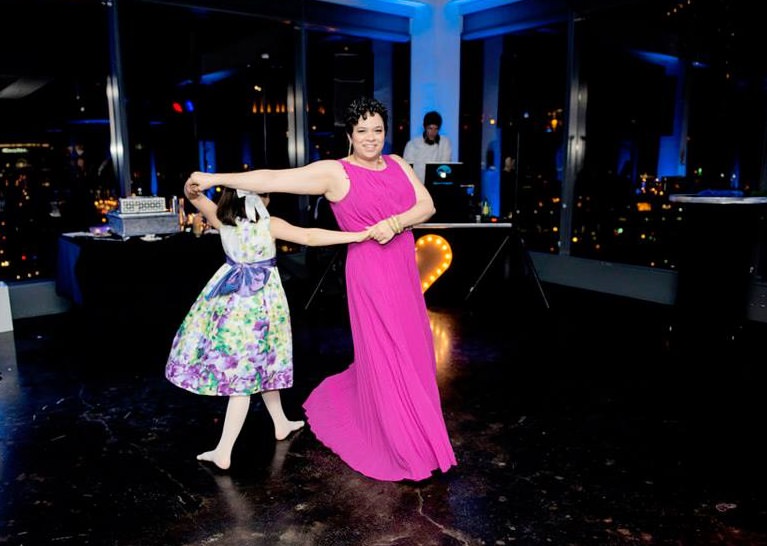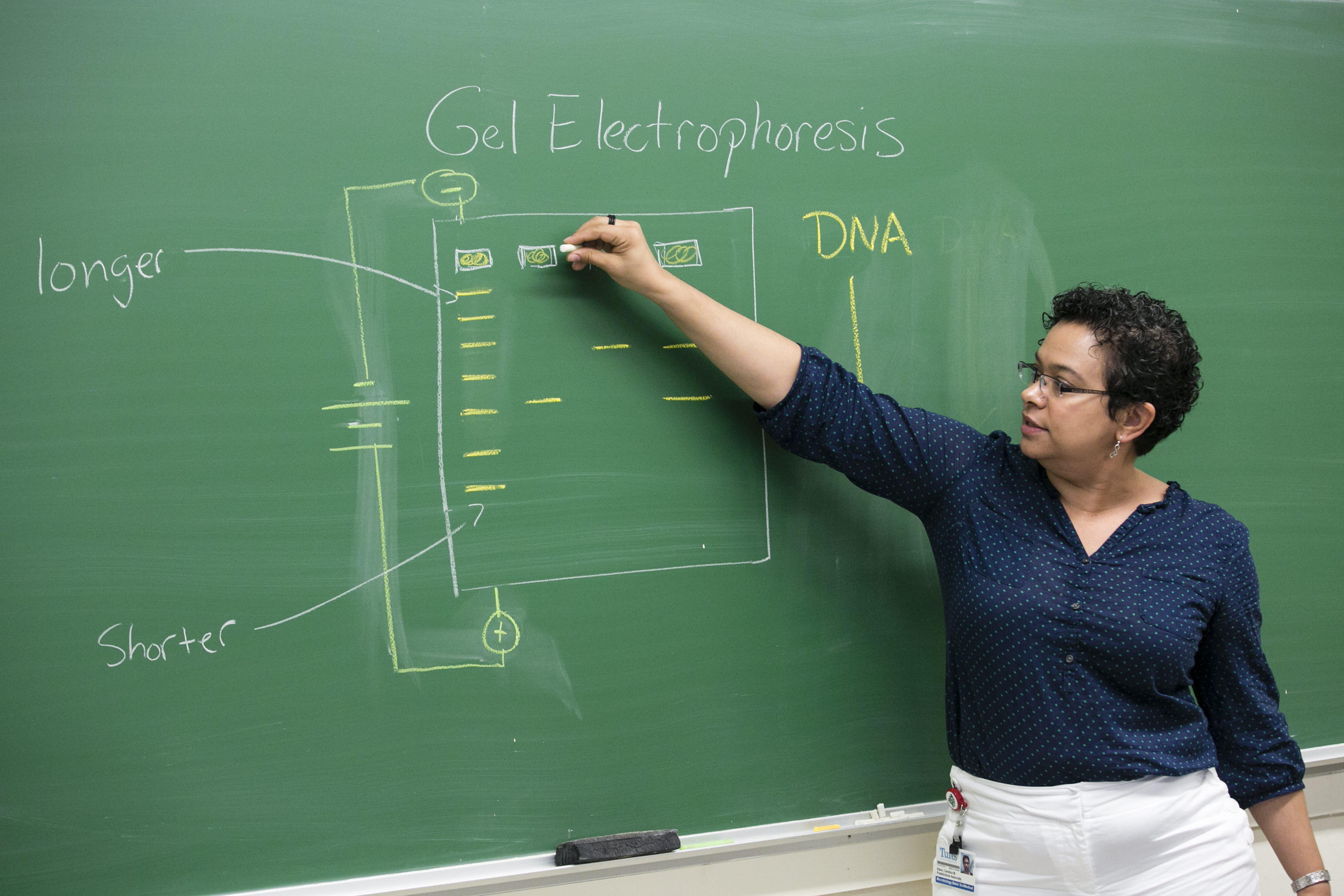“When I was little I would say that I wanted to be a doctor during the day and perform in ballets at night. It turned out a little differently,” says Candice Etson, Assistant Professor in the Department of Physics at Wesleyan University. Etson began training as a ballet dancer from the age of seven, and started her career as a dancer after graduating high school. “I performed and choreographed professionally, both in ballet and in other dance genres, and I got my bachelor’s degree in Fine Arts from New York University with a major in dance,” she says. After a few years, she decided that she was ready to stop performing, and returned to school.
She had always been interested in science, and in high school her parents encouraged her to take the most difficult science and math courses, even as she was training to be a professional ballet dancer. “I wanted to go to a performing arts high school,” Etson explains, “but they wouldn’t let me because they wanted me to get a solid academic education, not just learn about the arts.” That strong science foundation helped Etson as she started at Hunter College of the City University of New York, pursuing a second bachelor’s degree with intentions of becoming a medical doctor.
Etson’s mother had been a middle school math and science teacher, and her father an electrical engineer who was involved in the development of the first Automatic Teller Machines (ATM). “Science was definitely something we talked about at home, but I didn’t really have a good sense of how a person would become an academic scientist,” she says. In her introductory physics class, she realized that she loved the subject, but was unsure about what careers would be open to her should she pursue a physics degree. “I asked the professor about careers in physics," Etson explains. “He was very encouraging, and suggested that I apply for the Minority Access to Research Careers (MARC) scholarship.” She took his advice and was selected as a MARC scholar, which supported her to continue toward earning her bachelor’s degree in physics.
 |
| Etson dancing with her daughter. |
As part of the MARC program, Etson was able to do research in an optics lab at Hunter College and spent a summer working in Steven Siegelbaum’s neuroscience laboratory at Columbia University. While she was at Columbia, Etson attended a talk about research using simulations based on molecular forces to try to link together various crystal structures of ion channels to create an animation of how they might move during gating. “I thought that was incredibly fascinating, and I started asking people lots of questions about it,” she says. “One friendly postdoc told me that I should think about studying biophysics, and he even pointed me to the Biophysical Society website. I was hooked, and I decided that I wanted to study biophysics in graduate school.”
Etson went on to a PhD program in biophysics at Harvard University, studying in the lab of Antoine van Oijen. During her PhD studies, Etson became interested in single molecule techniques, which she uses in her work today. “I was always dissatisfied with the very deterministic descriptions of biological processes that I had heard in less advanced coursework. My physics training made me feel that these descriptions could not be realistic,” she explains. “I really got excited about the idea that when you study these processes at the single molecule level, their stochastic nature is evident – events don’t all happen at a set time when you’re dealing with single molecules.” She began using single molecule techniques immediately thereafter. Van Oijen recalls, “Candice worked on a number of quite elegant single-molecule experiments in my group. She used fluorescence imaging tools to visualize how proteins move along DNA and used her knack for physics to describe some of the molecular properties that determine how proteins interact with DNA.”
Following her PhD, Etson began a postdoctoral fellowship in the lab of David Walt at Tufts University, as part of the Training in Education and Critical Research Skills (TEACRS) program. “TEACRS postdocs spend 75% of their time in the lab, and the rest of the time is spent on career development, including training in all aspects of teaching,” she says. Etson worked on developing new methods of studying the activity of restriction endonucleases at the single molecule level. She used fluorescence spectroscopy and single molecule imaging in this endeavor. “The methods I developed can also be applied to other enzymes that modify nucleic acids,” she explains.
After completing her TEACRS fellowship, Etson stayed on in the Walt lab to continue her research. She also worked on a science outreach project called Bioinformatics Inquiry through Sequencing (BioSeq). “We set up a sequencing center that is for educational use, and we developed hands-on, open-ended experimental lab modules designed to introduce high school students to next generation sequencing and bioinformatics,” Etson says. “I really enjoyed this project because doing science with high school students requires a whole different mindset, and I learned a lot about education and how to engage people.”
Last year, Etson began her new position as Assistant Professor of Physics at Wesleyan University. She is currently using Total Internal Reflection Fluorescence (TIRF) microscopy to study how proteins interact with DNA. “Most recently, I have been using TIRF microscopy to observe the cleavage of DNA at the single molecule level,” she elaborates. “By characterizing the distributions of the times at which the individual events occur, it is possible to uncover the presence of reaction intermediates that cannot be directly observed.” At Wesleyan, Etson plans on continuing this work while expanding the methods she uses. “I plan to move into single-molecule Förster Resonance Energy Transfer (smFRET) studies to get more information from my experiments,” she says.
 |
| Etson teaching. |
Etson also plans to continue working with undergraduate students in her new position, exposing them to research opportunities. “I really enjoy working with novice researchers and introducing people to the practice of science. It’s so much better than studying from a textbook,” she says. “People tend to think that science, and especially physics, is really hard. It’s not easy, but I don’t believe it is as difficult as some people think it is. There is a lot of beauty in science, and I love it when I can help students see that beauty for themselves.”
Van Oijen believes that Etson will be a great example for her students. “Candice is a fantastic role model for young scientists. She has been able to launch a successful career as a scientist having started in a non-traditional way and while having a family,” he says. “I hope that students at Wesleyan are smart enough to pick her lab for their thesis research!”
Etson’s life is not all science, all the time. She is married with two daughters, and loves spending time with her family and also engaging her artistic side. “That includes cooking, sewing, knitting, and even building things for around my home,” she shares. “I also take the occasional dance class, and volunteer backstage when my daughters perform.”
Throughout Etson’s career, she has benefitted from the time and energy her advisors and other scientists expended for her, and hopes to continue this tradition with her own students. “I admire all of those people who were willing to give their time to share their knowledge and to encourage me to continue along the path to becoming an academic scientist,” she says. “Each of them had plenty of reasons that they could have been too busy for me, but they took the time anyway. I never want to forget how important five minutes can be for someone who is trying to find his or her path.” Her first piece of advice for young scientists? “Try things. Get as many different research experiences as possible before you choose something to specialize in. Sometimes the things you like to read about don’t turn out to be a good match for your way of thinking or working in the lab. Find a good match so that you can enjoy your work.”